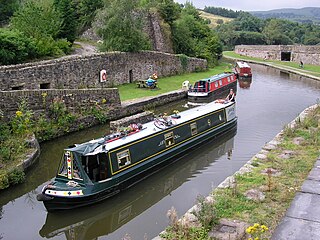
A towpath is a road or trail on the bank of a river, canal, or other inland waterway. The purpose of a towpath is to allow a land vehicle, beasts of burden, or a team of human pullers to tow a boat, often a barge. This mode of transport was common where sailing was impractical due to tunnels and bridges, unfavourable winds, or the narrowness of the channel.

A narrowboat is a particular type of canal boat, built to fit the narrow locks of the United Kingdom. The UK's canal system provided a nationwide transport network during the Industrial Revolution, but with the advent of the railways commercial canal traffic gradually diminished and the last regular long-distance traffic disappeared in 1970. However, some commercial traffic continued into the 1980s and beyond.

The Oxford Canal is a 78-mile (126 km) narrow canal in central England linking Oxford with Bedworth via Banbury and Rugby. Completed in 1790, it connects to the River Thames at Oxford and is integrated with the Grand Union Canal—combined for 5 miles (8 km) close to the villages of Braunston and Napton-on-the-Hill, a canal which soon after construction superseded much of its traffic.

The British canal system of water transport played a vital role in the United Kingdom's Industrial Revolution at a time when roads were only just emerging from the medieval mud and long trains of packhorses were the only means of "mass" transit by road of raw materials and finished products. The UK was the first country to develop a nationwide canal network.
Lionel Thomas Caswall Rolt was a prolific English writer and the biographer of major civil engineering figures including Isambard Kingdom Brunel and Thomas Telford. He is also regarded as one of the pioneers of the leisure cruising industry on Britain's inland waterways, and as an enthusiast for both vintage cars and heritage railways.

The canals of the United Kingdom are a major part of the network of inland waterways in the United Kingdom. They have a colourful history, from use for irrigation and transport, through becoming the focus of the Industrial Revolution, to today's role of recreational boating. Despite a period of abandonment, today the canal system in the United Kingdom is again in increasing use, with abandoned and derelict canals being reopened, and the construction of some new routes. Most canals in England and Wales are maintained by the Canal & River Trust, previously British Waterways, but a minority of canals are privately owned.

Robert Fordyce Aickman was an English writer and conservationist. As a conservationist, he co-founded the Inland Waterways Association, a group which has preserved from destruction and restored England's inland canal system. As a writer, he is best known for his supernatural fiction, which he described as "strange stories".

Tole painting is the folk art of decorative painting on tin and wooden utensils, objects and furniture. Typical metal objects include utensils, coffee pots, and similar household items. Wooden objects include tables, chairs, and chests, including hope chests, toyboxes and jewelry boxes.

The Standedge Tunnels are four parallel tunnels through the Pennine hills at the Standedge crossing between Marsden in West Yorkshire and Diggle in Greater Manchester in northern England. Three are railway tunnels and the other is a canal tunnel. Before boundary changes in 1974, both ends of the tunnels were in the West Riding of Yorkshire.
The IWA National Festival & Boat Show run by the Inland Waterways Association is one of the key annual events on the United Kingdom's inland waterways. Generally referred to as the "National" it serves several functions:

The Inland Waterways Association (IWA) is a registered charity in the United Kingdom and was formed in 1946 to campaign for the conservation, use, maintenance, restoration and sensitive development of British Canals and river navigations.

The Sapperton Canal Tunnel is a tunnel on the Thames and Severn Canal near Cirencester in Gloucestershire, England. With a length of 3,817 yards (3,490 m), it was the longest canal tunnel, and the longest tunnel of any kind, in England from 1789 to 1811.
Ellis Charles Raymond Hadfield was a canal historian and the author of many classic works on the British canal system, mostly published by the firm he co-founded, David & Charles.
The flyboat was a European light vessel displacing between 70 and 200 tons, used in the late 16th and early 17th centuries; the name was subsequently applied to a number of disparate vessels which achieved high speeds or endurance.

The Humber Keel was a type of sail craft used for inshore and inland cargo transport around Hull and the Humber Estuary, in the United Kingdom, particularly through the late 19th and early 20th centuries.

Narrow Boat is a book about life on the English canals written by L. T. C. Rolt. Originally published in 1944, it has continuously been in print since.

Sonia Rolt OBE FRS was a campaigner for the Inland Waterways Association (IWA) of Great Britain and was made an Officer of the Order of the British Empire in 2010 for her services to industrial archaeology and heritage.

Green and Silver is the account by Tom Rolt of a voyage through the inland waterways of Ireland just after the Second World War. It is notable because it was one of the last trips by any boat around the triangular loop of the River Shannon, Grand Canal and Royal Canal before the last named was closed to navigation. It was reopened in 2010.

A widebeam is a canal boat built in the style of a British narrowboat but with a beam of 2.16 metres or greater. Widebeams are found on the UK waterways, a canal and river system that is managed by the Canal and River Trust (CRT)

The boatwomen's training scheme was an initiative in the United Kingdom during the Second world war to attract women to work on Britain's canal network. Initiated by the Grand Union Canal Carrying Company (GUCCC) in 1942 the scheme was taken over by the Ministry of War Transport in 1944. The scheme closed after the end of hostilities in 1945. Nicknamed the Idle Women due to the Inland Waterways badge they wore in lieu of a uniform, it is estimated that approximately 100 women joined the scheme but only about 45 completed the training and only six are recorded as having participated throughout the length of the scheme.


















